
What is the difference between pelagic and demersal fish and where do they live
Have you ever wondered what is the difference between pelagic and demersal fish? But then there’s also reef fish, which live in and around coral reefs.
So what is the difference between pelagic and demersal fish? The difference between pelagic and demersal fish is pelagic fish live and feed in the open water column nearer to the surface (pelagic zone) away from the seabed, whereas demersal fish live and feed on the bottom (demersal zone). Pelagic fish include sharks and tuna, whilst demersal fish include flatfish and rays.
The best way to do more diving is to book yourself on a scuba diving liveaboard. You can check the latest and best deals on liveaboards using the following window:
To further understand the difference between pelagic and demersal fish, it’s best to first understand what each of these terms mean. To answer this question, I’m going to look at what pelagic and demersal fish are and the zones in the ocean where they live.
Also, what has all this got to do with scuba diving? I explain this at the end of this article.
What does pelagic fish mean?
Pelagic fish are so called because they live in the pelagic zone of the ocean (see below). Actually pelagic fish also live in lakes, as many lakes are deep and have pelagic zones too.
What’s actually meant by pelagic fish is, if a fish is pelagic, it means they live at some distance from the shore in the deep waters of the oceans. But pelagics live and swim in mid-ocean, which is neither close to the ocean floor nor near to the surface.
This is in contrast to demersal fish (see below), which live in the demersal zone, and bethnic fish (see below) which live in the bethnopelagic zone.
Pelagic fish thrive in areas of the ocean where there are strong currents. Where there are strong currents the oceans are rich in nutrients and oxygenated water. These rich nutrients attract smaller sea creatures, which provides food for the upward food-chain leading to the pelagics.
What is the pelagic zone?
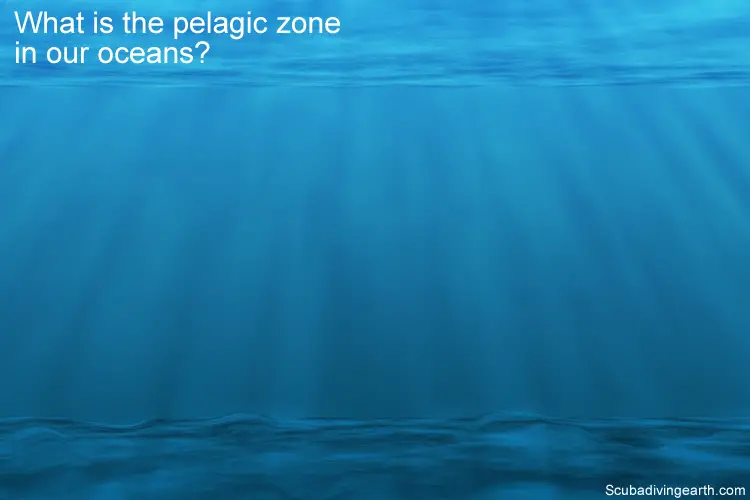
The pelagic zone relates to the deep areas of our oceans. In fact the word “pelagic” is derived from the Ancient Greek world pélagos, which means ‘open sea‘.
If you can imagine a column of water, with the bottom of this column being the ocean floor and the top being the surface of the ocean, pelagic fish live nearer to the surface part of this column of water.
Habitats zones change significantly between the ocean shores and shallow waters vs the deep ocean regions of the planet. The main differences between these habitat zones and where fish live is related to how deep the water is.
In general, the deeper the water, the greater the water pressure and the lower the water temperature. But also the deeper you go underwater, the less sunlight penetration you get too.
These differences in water pressures, water temperatures and the amount of sunlight create differences in the creatures that live in them.
According to Wikipedia, the pelagic zone occupies 1,330 million km3 (320 million miles3) of the world’s oceans. This area has a mean average depth of 3.68 km (2.29 miles).

Examples of pelagic fish – Is tuna a pelagic fish?
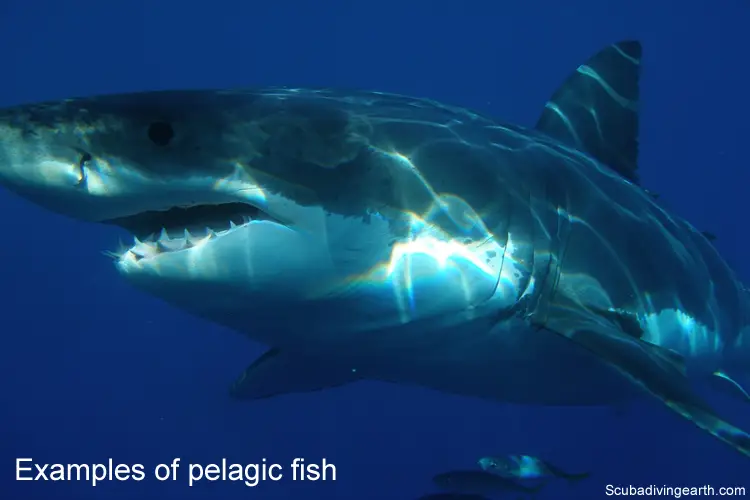
We tend to think of pelagic fish as the larger fish species, but pelagics also include smaller fish too. Here’s a list of a few of the larger pelagic fish you’ll find in the pelagic zone.
- Swordfish.
- Southern, Atlantic and Pacific bluefin tuna.
- Yellowfin tuna.
- Great white shark.
- Pelagic thresher shark.
- Blue shark.
- Great hammerhead shark.
- Shortfin mako shark.
- Oceanic whitetip shark.
- Porbeagle shark.
- Bull sharks.
- Whale sharks.
- Basking sharks.
- King Mackerel.
- Indo-Pacific Sailfish.
- Sunfish.
- Tiger sharks.
Let’s now take a look at demersal fish.
What does demersal fish mean?
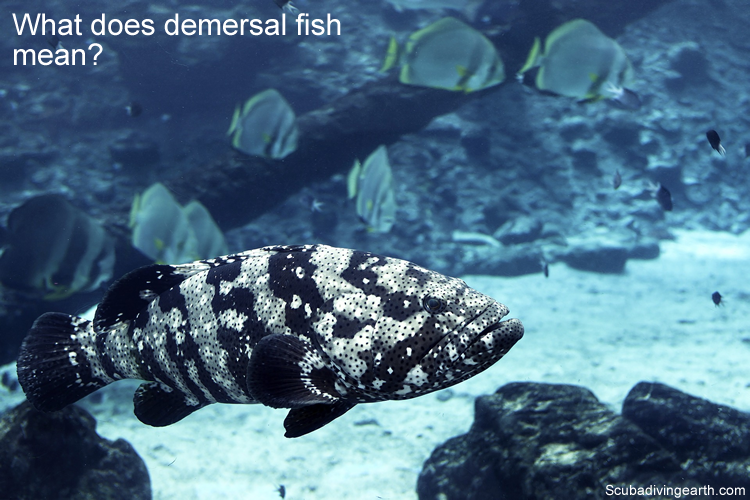
Demersal fish are so called because they live in the demersal zone of the ocean (see below). But like pelagic fish and the pelagic zone, this also applies to lakes too.
In contrast to pelagic fish, demersal fish live and feed on or near the bottom of seas or lakes.
Demersal fish are bottom feeders and are split into two types. The two types of demersal fish are benthic fish and benthopelagic fish.
What is the difference between benthic and benthopelagic fish?
The difference between benthic and benthopelagic fish is:
- Benthic fish which can rest on the sea floor, like flat fish and rays.
- Benthopelagic fish which swim in the water column just above the sea bed. A bit like if you imagine the opposite end of the pelagic zone. This includes fish like Atlantic cod and Atlantic herring.
Whereas pelagics swim in deep water near to the sea surface, benthopelagics swim in deep water near to the sea floor.
What is the demersal zone?

Using the same analogy of the water column, the demersal zone is the part of the column which is near to the sea bed. The demersal zone is above what’s known as the benthic zone, which is the lowest zone of the column of water and includes the seabed itself.
It’s important to distinguish between these two zones, as the fish that live and feed in these two zones are different.
The two types of fish that inhabit the demersal zone are split between those fish that are heavier than water and rest on the seabed (benthic fish), and those that have neutral buoyancy and remain just above the sea bed (
(benthopelagic fish).
The word demersal is derived from the Latin. The Latin word demergere, means ‘to sink‘.
Depending on where in the ocean we are talking about (or lake for that matter), will depend on how deep the demersal zone is. The deeper the water column and the lower down the demersal zone, the greater the water pressure is on the fish that live there.
The areas of the ocean where the demersal zone is in depths in excess of 200-1000 metres (700-3300 feet) is referred to as the aphotic zone. The aphotic zone is where no light penetrates and so no photosynthesis can take place.
Demersal zones is waters that are shallower than around 200 metres(700 feet) where photosynthesis can take place are called photic zones.
Examples of demersal fish
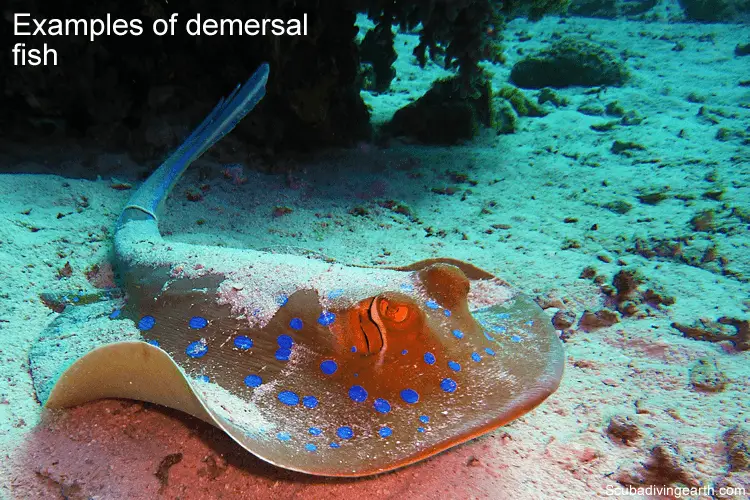
Here’s a list of a few of demersal fish you’ll find in the demersal and benthic zones of our oceans:
- European and American plaice.
- Turbot.
- European and winter flounder.
- Atlantic, Pacific, Californian and Greenland halibut.
- Lemon sole.
- Atlantic cod.
- Atlantic herring.
- Brill.
- Great hammerhead shark.
- Devil fish.
- Blue spotted ray.
- Spotted eagle ray.
- Great freshwater stingray.
- Southern stingray.
The first half of the above list sounds a bit like a menu at a fish restaurant, doesn’t it? Sorry I couldn’t resist saying that!
In summary the difference between pelagic and demersal fish is where they live in our oceans, which affects how and what they feed upon. However, the way they swim in the ocean is similar, as they swim using neutral buoyancy.
For completeness of this article, what is the difference between benthic and pelagic fish?
What is the difference between benthic and pelagic
Finally, the difference between benthic and pelagic fish is similar to the difference between demersal and pelagic really, except for a matter of a few feet to the seabed, which is where the benthic fish live vs demersal fish.
However, the similarity between demersal fish that are benthopelagic and pelagic fish is these are both types of fish that swim using neutral buoyancy. This is in contrast to benthic fish, which live on the seabed and are heavier than the surrounding water.
The difference between benthic fish and pelagic fish is therefore not just a difference in the region of the ocean where they live, but also in the way they live and swim in the ocean.
If you compare for example, a swimming shark and a bottom living stingray, whilst a shark and a stingray are both of the same species and are cartilaginous fish, the way they swim in the oceans and how they live is quite different.
A shark is a pelagic fish and lives mostly in the pelagic zone (although there are exceptions to this and some sharks live in the demersal zone for some periods too). Whereas stingrays are benthic fish, living on the seabed and are heavier than the surrounding water.
Now I explained the differences between pelagic fish, demersal fish and benthic fish, what has all this got to do with scuba diving you might say?
What has knowing the difference between demersal pelagic and benthic fish to do with scuba diving?
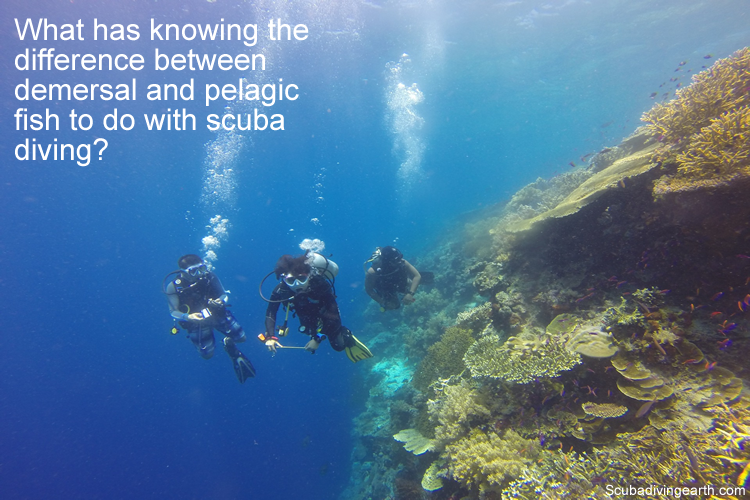
When you first start out scuba diving as a beginner, most of your diving will be done in the demersal zone and mostly see demersal fish and benthic fish.
This is because as novice diver you are still trying to master your buoyancy control. As a beginner diver, you’ll also be diving in and around shallow coral reefs, where you’ll experience reef fish.
It’s much easier to master buoyancy control when you have the sea bed just below you (i.e. the demersal zone and benthic zone), rather than several hundred or 1,000’s of metres of feet below you (in the pelagic zone).
Once you’ve mastered your buoyancy control and as you gain confidence with your diving equipment, you can then progress to diving in the pelagic zone.
I love diving in the pelagic zone, as it’s where you’re more likely to see sharks when scuba diving. I love to scuba dive with sharks. If you do too, or if you’d like to try it, then by progressing your diving experience and certifications, you’ll be able to dive in this zone too.
But that’s not to say you won’t see sharks in the demersal zone or on reefs, because you will. There’s plenty of shark action in the demersal zone. Places like Tiger Beach in the Bahamas is a great place to see tiger sharks, along side hammerheads, bull sharks and reef sharks.
The other factor that you need to be aware of in the pelagic zone is they often have currents to contend with. This means that your dive will either be a drift dive or you’ll be hooked to a static line.
Both of these diving types require further training and experience.
But then on the other side of this coin, there are plenty of exciting demersal and benthic fish to enjoy and see when you dive in the dermal and benthic zones.
I hope you enjoyed this article about what is the difference between pelagic and demersal fish
I’d love to hear from you. Tell us about your adventures of diving and snorkeling, in the comments below. Please also share your photos. Either from your underwater cameras or videos from your waterproof Gopro’s!
If this article hasn’t answered all of your questions. If you have more questions either about snorkeling or scuba diving (or specifically about what is the difference between pelagic and demersal fish), please comment below with your questions.
There will also be many more articles about scuba diving (and snorkeling) for you to read and learn about these fabulous sports.
Have fun and be safe!




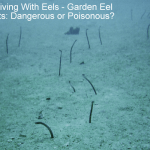
you have a mistake in the first paragraph
Hi Jim, thank you for your comment, things like this are always appreciated. I have read and re-read the first paragraph and cannot spot the mistake…please will you let me know what it is you see, thank you.
“Demersal fish include sharks and tuna, whilst demersal fish include flatfish and rays.”
Now can you spot the error?
Hi Mack, thank you…I was blind to my own error and duly corrected. Really appreciate your reading this closely and taking the time to critique, thank you. Russell
You are welcome Russell. Thank you for uploading this page to explain the fish classification system used by marine biologists. Ornithologists classify birds by foot shape, not by the altitudes of their flight.
Hi Mack, thank you for your engagement with my writing…it’s having readers like you that makes blogging worthwhile for me and worth all the effort of writing what I do. Are you a scuba diver as well as an Ornithologist (I’m assuming you are an Ornithologist as you mention it?)
No, I am neither. The closest that I have got to scuba diving, has been snorkling at two sites: Hikkadua in Sri Lanka, and Tioman Island in Malaysia, both around 30 years ago. At that time, both locations had shallow (3 – 6 metres depth) coral reefs. This allowed a snorkler like myself, to view the rich biodiversity at both locations first-hand. In Hikkadua I viewed phosphorescent (bioluminescent) scallops embedded in coral, huge groupers – such majestic fish, and a couple of huge green turtles, who were returning to the open ocean after laying eggs on the beach – they scared the shit out of me as they’re so well camoflaged against the green seawater and were gigantic. They swam right past me and I had no idea what they were until they had passed me by. The sandy seabed was littered with spiny black sea urchins and a variety of brightly coloured reef fish swam among the coral formations. In Tioman I saw reef fish, sea cucumbers, jellyfish and brightly coloured coral. I too am based in the UK (in London).
As far as birds go, the nearest encounters I have had with them are the usual bold robins who inspect the soil for worms etc when I’m digging up the flowerbeds in springtime, some noisy ringtailed parakeets who live in a park near me and raid our apple tree for fruit, and a couple of magpies and pigeons who grace our garden from time to time.
Hi Mack, thank you for the update – love snorkeling too. In fact I snorkelled for my early life and only started scuba diving in my 20’s when I live in Australia and dive the Great Barrier Reef, which was my very first dive. What an amazing first experience for me. By the way I love turtles, they are great creatures to see when diving, but what I really love to see are sharks!!